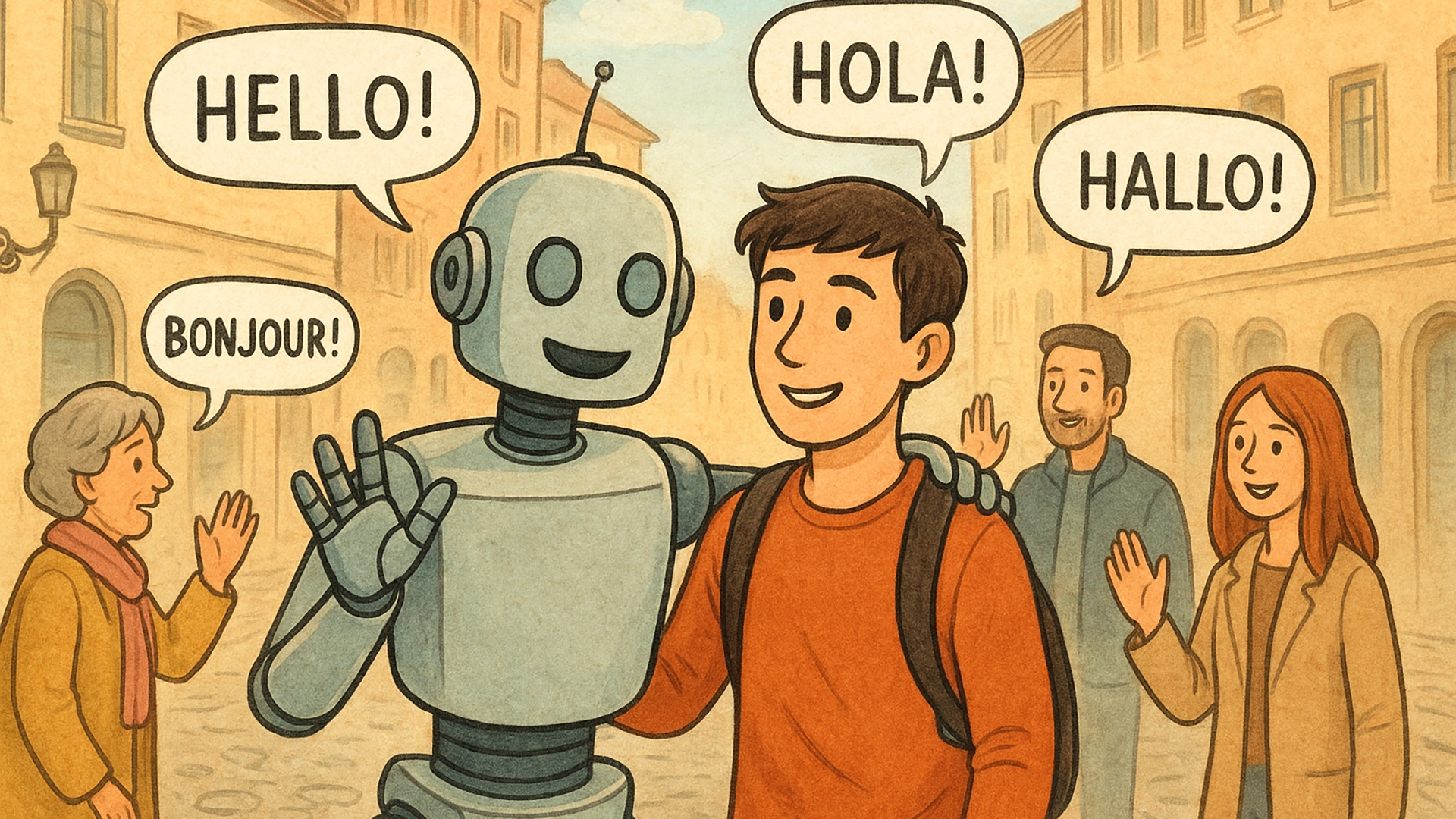
Image generated with ChatGPT
Opinion: Multilingual Tech Is Booming—Are Tech Giants Making Language Learning Obsolete?
The latest AI tools now support dozens of languages. From chatbots that interact fluently in 60 languages to headphones that provide travelers with live translations, multilingual tech is booming. But what does this mean for language learning?
It feels like ages ago now, but when ChatGPT was first launched, it performed far better in English than in other languages. In many, it was frankly unusable. However, generative AI has significantly improved since 2023, and language barriers have been shattering—especially this year.
Now, I have friends who chat with AI in Spanish, French, German, Italian, and even minority languages such as Catalan, with outstanding results and impeccable grammar.
ChatGPT now supports around 60 languages. Tech companies are racing to expand their reach, adapting to hundreds of regions and communities, fine-tuning for accents, and even accommodating hyper-local expressions.
Google Translate’s traditional use already feels outdated. It’s being overtaken by tools such as real-time translation devices, voice-enabled chatbots that double as interpreters, and automated video translation services.
So why are tech companies investing so heavily in multilingual tools? Will AI truly erase language barriers? And if so—does that make language learning obsolete?
Tech Companies Are Translating Everything
Generative AI has had a big impact on languages in 2025. Duolingo, for example, didn’t just add AI-powered features—it reinvented itself as an AI-first company. Its lessons are now designed by AI, and it recently launched 148 language courses with its new AI program. But will people still need to learn languages? Other tech companies seem to emphasize—through significant actions—that language learning may soon be optional, pursued more for pleasure than necessity.
Google, for instance, has been rolling out its popular AI tool NotebookML in more than 80 languages, allowing users from different cultures to access the technology and its advanced audio and video features. The tech giant also upgraded its popular Google Translate app with new features such as language learning capabilities—directly competing with Duolingo—and translating live conversations—now available in over 70 languages.
A couple of days ago, Meta started to roll out AI dubbing in English and Spanish for Reels. I’ve already seen multiple videos from English-speaking content creators “speaking” in Spanish. It’s weird. The visuals feel a bit uncanny—synthetic voices and slight video distortions—but the functionality is undeniably impressive.
And perhaps the most ambitious move came just last week, when Apple introduced the new Airpods Pro 3. The company launched a fascinating feature: Live Translations. In Apple’s demo, the AirPods translated a Mexican florist’s explanation of flower prices for an English-speaking tourist, and even mediated a conversation between two people speaking different languages in a restaurant.
Apple’s new AirPods Pro 3 have live translation between languages,
On one hand, handy. On the other hand, a bit science-fictioney? pic.twitter.com/l9MFDXafsK
— Adrian Weckler (@adrianweckler) September 9, 2025
Of course, the new feature hasn’t reached a wide audience yet, and we are still missing the real-life reviews. Hopefully, in the near future, travelers won’t have to end up in Tunis, Tunisia, instead of going “To Nice,” France—although we might lose some of the fun.
Multilingual Tech Is Part Of The AI Race
While translating and localizing technologies into dozens of languages does expand access to valuable information for communities worldwide, the motivations behind these efforts aren’t purely altruistic.
For tech giants, “massive AI adoption” ultimately translates into “money and power.”
The AI race is exciting and highly competitive. For most companies, the primary objective isn’t just building smarter tools—it’s driving adoption. The more people use their platforms, the more engagement they capture, and the easier it becomes to sell products, services, and even ideas.
Language expansion, then, is less about inclusion and more about markets. By covering more languages, tech companies unlock new customer bases across cultures, geographies, and industries. At this stage, profitability takes a back seat. What matters most is winning.
Will Language Learning Die?
So, if our phones and headphones can instantly translate any language into our own, who’s going to learn a new language? Probably only the stubborn—or the sentimental—people like me.
Practically speaking, these innovations mean we’ll soon be able to travel anywhere and communicate without ever studying the local tongue. Language skills may no longer be required for professional roles or even offer an advantage in the job market.
This is why I’ve been bearish on language learning for years. Unless you live or work full-time somewhere, better to master another craft while letting AI do the translation pic.twitter.com/HrT5CXoH9e
— Josh Constine 📶🔥 (@JoshConstine) March 13, 2025
On social media, some argue that language learning will become a niche hobby, like playing chess or solving a Rubik’s Cube. Others warn about a larger gap between those who can access devices such as AirPods that enable live translations and those who cannot.
Still, the latest tools raise more questions than they answer. What happens in crowded and noisy places? Will ChatGPT be able to listen clearly and translate a group’s conversation if it already struggles with minor interruptions? Will the AirPods pick up the gossip at the next table and miss the soft-spoken words of a loved one sharing difficult news in another language? And the most important question of all: can we blindly trust AI translations for our most human experiences?
In the end, fully relying on new technologies for communications becomes another trust exercise, while learning a new language becomes an exotic and artful choice for human connection.


 Previous Story
Previous Story

 Latest articles
Latest articles 